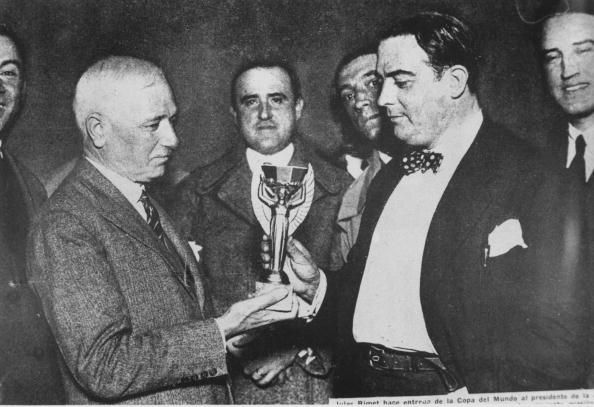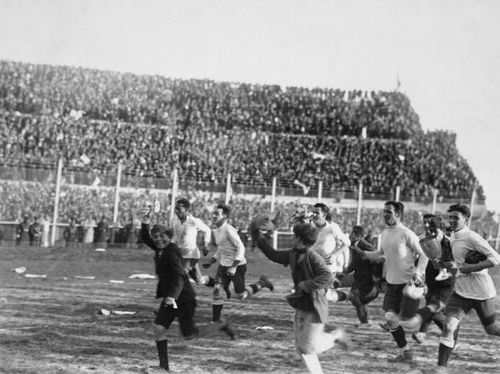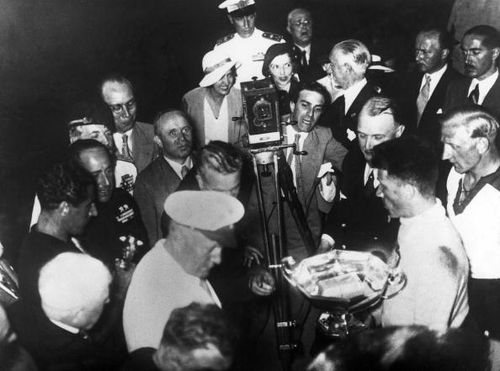
Memories of the World Cup: 1930 to 1938

Every FIFA World Cup produces certain moments, matches, controversies that leave an indelible mark not only on that tournament but also on footballing history. With passage of time these become the memories ofthe World Cup: events that define the tournament and stay in the minds of people forever. In this multi part series, we look at such memories from the first World Cup in 1930 to the 1938 World Cup held in France.
Uruguay 1930: Free-spirited and Amateur

The first FIFA World Cup held in Uruguay was a free-spirited and amateur affair. Uruguay was a dominant footballing force then and had underlined their dominance by winning the gold in 1928 Olympics.
Argentina and Uruguay contested the final in front of 93,000 fans at the Estadio Centenario in Montevideo. The hosts took the lead only for the Argentines to restore parity and take the lead in the 37th minute.
Uruguay then mounted a strong comeback in the second half putting three more goals past Argentina and winning the first ever FIFA World Cup. Despite being a new tournament, the World Cup had succeeded in capturing the imagination of fans, especially in South America. As many as 15000 Argentines made the trip to the Uruguayan capital to watch the final in Montevideo.The fact that most of them failed to reach the stadium on time is a different matter altogether as arrangements to bring people to Montevideo proved inadequate.
However, the essence of the tournament is captured in the words of Lucine Laurent, the French forward who holds the distinction of scoring the first FIFA World Cup goal against Mexico: "Of course, back then I couldn't have imagined the significance the goal would have. We didn't even know the World Cup would last. I remember when I got home, there was just a tiny mention in one of the papers. Football was in its infancy”.
Italy 1934: Mussolini’s imprint and a triumph for Fascism

By 1934, football had become the most popular sport in the world; capturing the imagination the masses like no other sport had ever done before. In fact, national football became a focal point around which national identities were built. And who better to tap into this than Benito Mussolini, the Italian fascist ruler who, like Hitler in Germany, never bypassed any opportunity to showcase his regime’s achievements to the world.
Similar to Hitler during the 1936 Berlin Olympics, Mussolini’s imprint was all too visible at the 1934 World Cup held in Italy. Il Duce’s involvement was so intense that it made Jules Rimet, the then Fifa President and against whose name the trophy is now named, remarked: “FIFA are not organising this tournament, he is.”
So obsessed was Mussolini with his Azzuri lifting the world title that he personally decided the match officials for every game. This led to many countries decrying the tournament as a fiasco. Refereeing controversies defined the tournament as it headed into the knock out stages.
The quarter final between Italy and Spain turned out to be one of the ugliest games in World Cup history with both teams playing in a highly aggressive manner; leaving many players from both teams injured. The match ended 1-1 after extra time, hence forcing a replay which the home side won 1-0 in a match marred by dangerous physical play that forced three Spanish players to leave the field(No substitutions were allowed during that time).
The semi-final against pre-tournament favourites Austria was an even bigger fiasco. Mussolini appointed a young Swedish referee Ivan Eklind and there had been rumours of Il Duce bribing the Swede before the game. One match report even said that Eklind intercepted a pass by an Austrian player. Despite all this, Italy found it tough to score against the Austrians and had to rely on a dodgy offside goal to prevail 1-0 and reach the World Cup final. Mussolini’s dream was about to be fulfilled.
Italy’s opponents in the final were Czechoslovakia- an entertaining but young team who reached the final after beating Germany 3-1 in the semi-final. Unsurprisingly, Mussolini again installed Ivan Eklind as the referee for the final.
By now, Mussolini and the Italian coach Vitorio Pozzo had whipped the nation into a frenzy.The final at the Stadium Nazionale in Rome was another game in which the referee turned a blind eye to persistent foul play by Italians. Though the Czech’s took the lead in the 71st minute, Raimundo Orsi restored parity before Angelo Schiavio wrote himself into history books by scoring in the 95th minute.
Mussolini’s dream was fulfilled and the celebrations that followed the win seemed more like a celebration of fascism, illustrated by the fact that the fascist anthem ‘Giovinezza’ was blaring out throughout the stadium. All these political shenanigans overshadowed the fact that the Italians were a very good footballing side. They would go onto claim their 2nd world title in 1938.
France 1938: In the shadow of war, Italy thrive

Following the politically charged tournament of 1934 and the Berlin Olympics of 1936, FIFA decided to play it safe and a decision was made to stage the tournament in France. This caused outrage among the South American countries with Argentina being denied the right to host the tournament. Argentina felt they were entitled to host the competition as part of FIFA’s plan to alternate the tournament between Europe and South America.
With most American nations refusing to participate in the tournament, Brazil and Cuba qualified without even kicking a ball. This is the first and only World Cup to have featured Cuba. England, Wales and Scotland did not participate in the tournament. Meanwhile, Spain was engulfed in a civil war of its own and did not send a team.
Defending champions Italy, though, were the story of the tournament. With their tournament win at home shrouded in controversy and Europe on the brink of war, the Azzuri were by no means the most popular team as Mussolini, alongside Hitler was responsible for the continent being on the boil by then. Italy were consistently booed during their games and quite unsurprisingly they seemed to revel in it.
Things came to a head for the Italians in the quarter-final against the home side. As both sides traditionally wore blue shirts, Italy were asked to sport their away kit, which was traditionally white. Mussolini intervened and the Italians instead turned up in black shirts, a symbol of the much feared fascist paramilitary. Further stoking the fire, Mussolini asked his players to hold their fascist salutes before kick-off until the crowd stopped booing.Led by the creativity of Giuseppe Meazza, Italy prevailed 3-1.
The Italians then overcame Brazil 2-1 in the semifinals to reach the championship round. On the other side, Hungary reached the finals by breezing past Sweden 5-1. In the final held at the Stade Olympique de Colombes, Paris; Italy retaining the world title, overcoming Hungary 4-2. They would keep the title for 12 more years as World War II brought the World Cup- and life as people knew it, to a standstill.